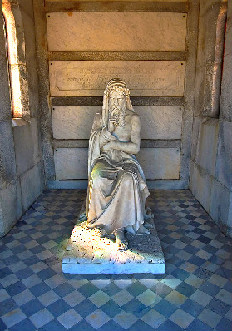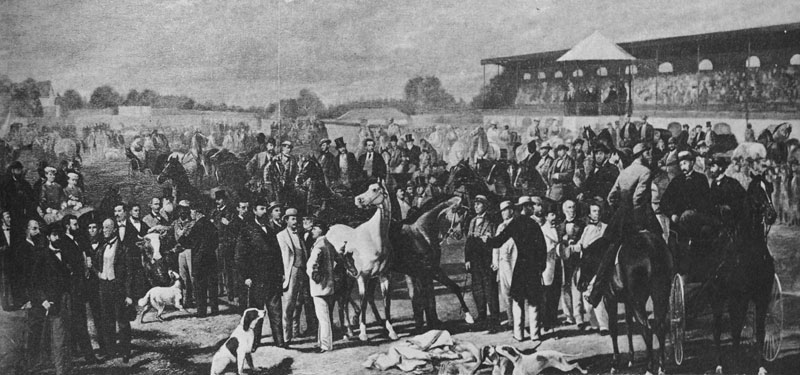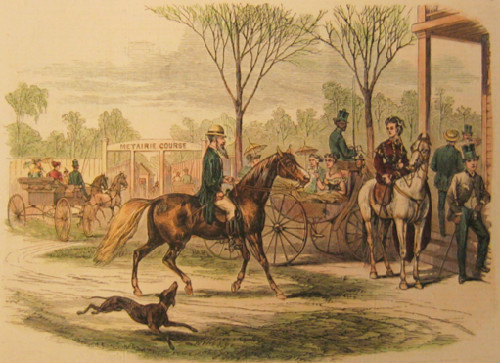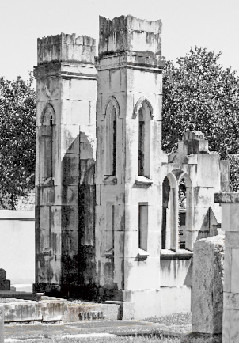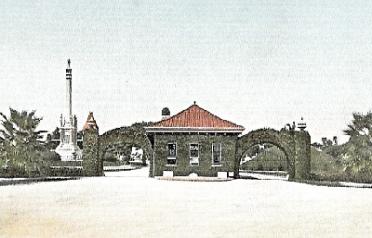| Old Metairie Track: From Race Course to Cemetery |
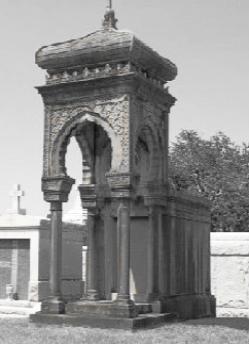

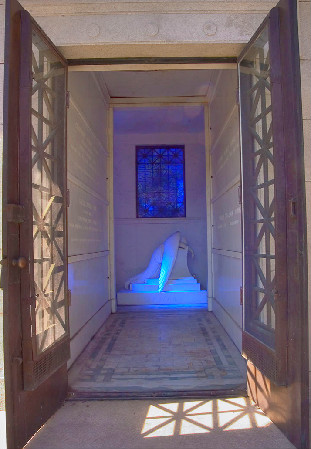
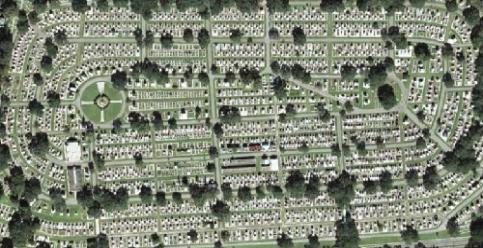
| Main entrance, Metairie Race Course, 1869; top image, Metairie Race Course, ca. 1850's. |
Many locations can boast of having an interesting history (in New Orleans, it might be more
difficult to find a spot that doesn't). But, for sheer irony, it's hard to top the location of what was
once the renowned Metairie Race Course. Lots of defunct racetracks have probably been turned
into supermarkets or condominiums, but how many have been turned into cemeteries? That was
the fate of the city's old Metairie Race Course - and, if legend is to believed, the unique
transformation came about because of some good, old-fashioned payback.
The exclusive Metairie Jockey Club, which owned the race track, supposedly refused
membership to Charles T. Howard, who had gained his wealth by starting the first Louisiana State
Lottery, and wasn't considered "old money" enough to be welcome. Miffed at being rejected, so
the story goes, Howard swore that he would see the Metairie Race Course turned into a cemetery.
In 1872, under the weight of financial difficulties, the racetrack was sold and Mr. Howard turned
his oath into action when he became one of the founders of Metairie Cemetery. The layout of the
racetrack was incorporated into the cemetery's system of roadways and, as you can see in the
image below, an aerial view of Metairie Cemetery clearly shows the outline of the old racetrack's
oval-shaped design.
difficult to find a spot that doesn't). But, for sheer irony, it's hard to top the location of what was
once the renowned Metairie Race Course. Lots of defunct racetracks have probably been turned
into supermarkets or condominiums, but how many have been turned into cemeteries? That was
the fate of the city's old Metairie Race Course - and, if legend is to believed, the unique
transformation came about because of some good, old-fashioned payback.
The exclusive Metairie Jockey Club, which owned the race track, supposedly refused
membership to Charles T. Howard, who had gained his wealth by starting the first Louisiana State
Lottery, and wasn't considered "old money" enough to be welcome. Miffed at being rejected, so
the story goes, Howard swore that he would see the Metairie Race Course turned into a cemetery.
In 1872, under the weight of financial difficulties, the racetrack was sold and Mr. Howard turned
his oath into action when he became one of the founders of Metairie Cemetery. The layout of the
racetrack was incorporated into the cemetery's system of roadways and, as you can see in the
image below, an aerial view of Metairie Cemetery clearly shows the outline of the old racetrack's
oval-shaped design.
Charles Howard died in 1885 (in, of all things, a horseback-riding accident) and was buried at the
location of his triumphant retribution. His tomb, complete with a mysterious statue of a man with
his finger to his lips (perhaps, an attempt to quieten the ghosts of the Jockey Club members who
are grumbling about his admittance?), can be found almost directly in the center of Metairie
Cemetery, where, one could say, he has been granted permanent and irrevocable membership.
location of his triumphant retribution. His tomb, complete with a mysterious statue of a man with
his finger to his lips (perhaps, an attempt to quieten the ghosts of the Jockey Club members who
are grumbling about his admittance?), can be found almost directly in the center of Metairie
Cemetery, where, one could say, he has been granted permanent and irrevocable membership.
| Statue in Charles Howard's tomb |
Metairie Race Course was founded in 1838. It became the most popular racetrack in the South
and was well-known throughout the nation. In the mid-1800's, New Orleans was considered one
of the leading horse-racing cities in the U.S. Former President Millard Filmore attended the
track's much-heralded Lexington-Lecompte contest of 1854. According to "Metairie Cemetery, An
Historical Memoir," the course's growth paralleled the growth of the city. New Orleans, in that
period, was becoming a mercantile and shipping center and a focal point for sports and
entertainment.
This romantic reminiscence of the Metairie Course is from Grace King's "New Orleans: The Place
and the People," published in 1895:
"When the memory of the race takes in, as it always does in New Orleans (for the turf was then a
pastime for gentlemen and ladies, not a business for professionals), the crowds in the hotels, the
noted men and women from all over the South, the whirl of carriages and cabs and vehicles of all
kinds along the shell road, the grandstand, exclusive as a private ballroom, glittering with lades
dressed from the ateliers of the great modistes, and with all those charms of beauty and conversation,
which in default of higher education, Heaven used then to supply women with...and the men
glittering, too, in all the pride, arrogance and self-sufficiency which their enemies, the moralists,
supplied them with...the field packed...the track - that superb track of old Metairie - the jockeys petted
and spoiled like ballet-girls - and the horses! A volume would not hold it all before we even get to
Lexington and Lecompte, and after that, a library would be needed to contain it.
"And the dinners afterward, at Moreau's, Victor's, Miguel's and the famous lake restaurants, with
their rival chefs and rival cellars. And, after that, again, the grand salons of the old St. Louis and St.
Charles, filled with everybody, and all enjoying themselves. That was what horse-racing meant then.
"Alas! the old Metairie is expiating its sins now as a cemetery, and its patrons - its beaux and its
belles and its horses - they are expiating their sins, too, in cemeterial ways."
and was well-known throughout the nation. In the mid-1800's, New Orleans was considered one
of the leading horse-racing cities in the U.S. Former President Millard Filmore attended the
track's much-heralded Lexington-Lecompte contest of 1854. According to "Metairie Cemetery, An
Historical Memoir," the course's growth paralleled the growth of the city. New Orleans, in that
period, was becoming a mercantile and shipping center and a focal point for sports and
entertainment.
This romantic reminiscence of the Metairie Course is from Grace King's "New Orleans: The Place
and the People," published in 1895:
"When the memory of the race takes in, as it always does in New Orleans (for the turf was then a
pastime for gentlemen and ladies, not a business for professionals), the crowds in the hotels, the
noted men and women from all over the South, the whirl of carriages and cabs and vehicles of all
kinds along the shell road, the grandstand, exclusive as a private ballroom, glittering with lades
dressed from the ateliers of the great modistes, and with all those charms of beauty and conversation,
which in default of higher education, Heaven used then to supply women with...and the men
glittering, too, in all the pride, arrogance and self-sufficiency which their enemies, the moralists,
supplied them with...the field packed...the track - that superb track of old Metairie - the jockeys petted
and spoiled like ballet-girls - and the horses! A volume would not hold it all before we even get to
Lexington and Lecompte, and after that, a library would be needed to contain it.
"And the dinners afterward, at Moreau's, Victor's, Miguel's and the famous lake restaurants, with
their rival chefs and rival cellars. And, after that, again, the grand salons of the old St. Louis and St.
Charles, filled with everybody, and all enjoying themselves. That was what horse-racing meant then.
"Alas! the old Metairie is expiating its sins now as a cemetery, and its patrons - its beaux and its
belles and its horses - they are expiating their sins, too, in cemeterial ways."
| Metairie Cemetery entrance, 1920; this entrance was constructed in 1883 and remained until 1953, when it was demolished to make way for the Metairie Road overpass. |
Today, Metairie Cemetery (which is actually in New Orleans, not Metairie) is considered the
most prestigious cemetery in the city, covering 150 park-like acres, with more than 7,000 graves.
On what's known as "Millionaire's Row" - and, really, throughout the entire cemetery - little
expense has been spared in erecting elaborate and often unique monuments. In 1991, Metairie
Cemetery was added to the National Register of Historic Places and, in 2003, it was named by
Forbes.com as one of the ten best cemeteries in the country.
If the old race course is atoning for its sins, as Grace King suggested, then it is surely doing so
in high style!
most prestigious cemetery in the city, covering 150 park-like acres, with more than 7,000 graves.
On what's known as "Millionaire's Row" - and, really, throughout the entire cemetery - little
expense has been spared in erecting elaborate and often unique monuments. In 1991, Metairie
Cemetery was added to the National Register of Historic Places and, in 2003, it was named by
Forbes.com as one of the ten best cemeteries in the country.
If the old race course is atoning for its sins, as Grace King suggested, then it is surely doing so
in high style!
| Current photos of what I believe to be the most beautiful statuary in Metairie Cemetery; it can be found inside the Chapman Hyams tomb. The weeping angel is continually bathed in soft blue light from the stained glass window behind it. It's a very moving scene. |
| Metairie Cemetery is filled with grand and unusual tombs. Right, the Egan family tomb, modeled on the ruins of an old abbey which was situated on the grounds of their ancestral estate in Ireland. The tomb's designer traveled to Ireland and faithfully copied the abbey's ruins, down to every crack in the ruin's stones and every hue in the aging color of the structure. Below, left, the pyramid and sphinx tomb of Lucien Brunswig. Below, right, Charles Larendon's tomb of intricate middle-eastern design. |
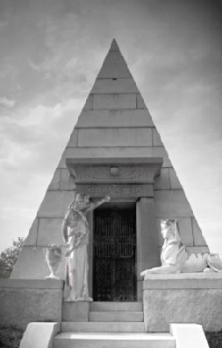
| Please don't use the "Send Page" feature of your computer to send this entire page in an e-mail message or document format. If you'd like to share it, please just send the link. The link to this page is: http://old-new-orleans.com/NO_MetairieRaceCourse.html Back to Old New Orleans The Past Whispers - Home |
